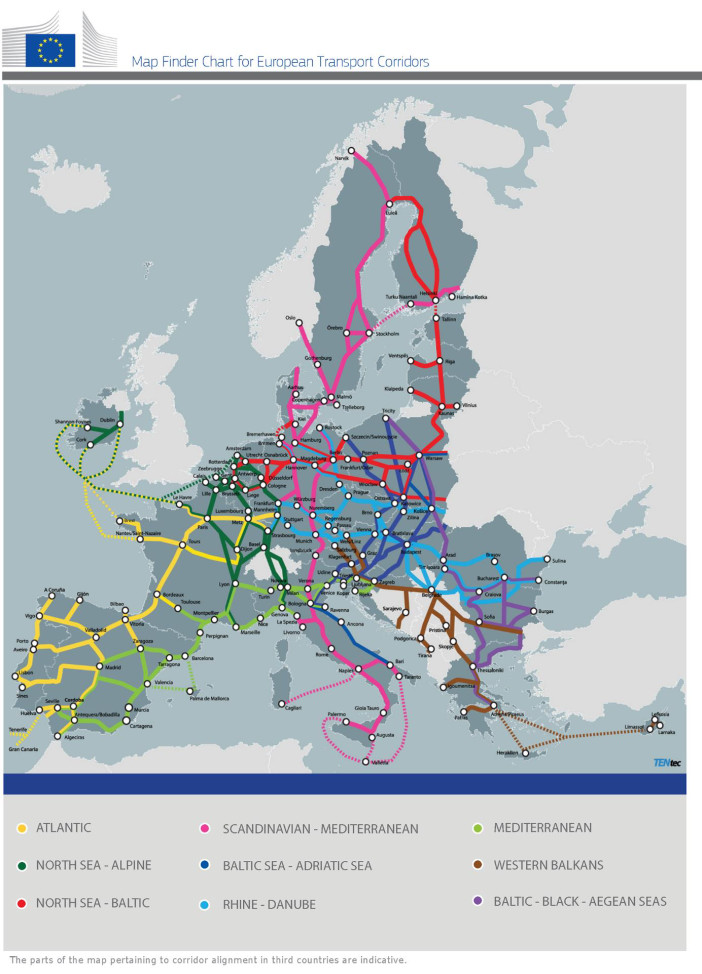


Networks
Trans-European Transport Network (TEN-T)
Objective
The Trans-European Transport Network (TEN-T) is a set of rail, road, air and water transport networks in the European Union. They provide integrated and intermodal long-distance high-speed routes across the continent by taking away border obstacles and removing gaps in the network that hinder cross-border traffic. This ‘flagship’ project of the EU Transport Policy aims at developing European transport infrastructure to deliver a genuine Single European Transport Area (SERA).
The TEN-T network for rail (amongst other modes) is governed by Regulation (EU) No 1315/2013 on Union guidelines for the development of the trans-European transport network. The TEN-T is composed of two layers:
- a core-network of routes which should be implemented by 2030, and
- a comprehensive network which should be implemented by 2050.
On 14th of December 2021, the European Commission (EC) presented a comprehensive proposal for revised TEN-T Guidelines. The proposal introduces a new intermediary network layer to be implemented by 2040. The aim is to advance the completion of major parts of the comprehensive network and the concept of European Transport Corridors, which merges the RFC corridors with the TEN-T corridors. It also proposed more ambitious technical and operational requirements for rail infrastructure.
On 22nd July 2022, following the military aggression of Ukraine by Russia, the EC published an amended proposal to extend the TEN-T network to Ukraine and Moldova while removing connections to Russia and Belarus. It also proposed to harmonise the different track gauges to the European standard.
On 5th December 2022, the Council adopted its position (“general approach”) and on 13th April 2023 the EP TRAN Committee adopted its report and decided to enter into interinstitutional negotiations (trilogue).In April 2023, the trilogue negotiations started under the Swedish Presidency of the Council of the EU and continued since 1st July 2023 under the Spanish Presidency. On 18th December 2023, following the 5th trilogue, a provisional agreement was found by all parties on the governance elements proposed by the EC as well as the modal-specific technical and operational requirements.
EIM in action
- EIM welcomes the political ambition of the EC regarding the TEN-T and rail infrastructure.
- EIM advocates to cater for increasing the EU financial framework proportionally to the new investment requirements.
- EIM closely followed the revision process and provided several in-depth analyses for its members.
- EIM exchanged frequently with the relevant EC services on the TEN-T negotiations.

EIM actions in 2023
- EIM produced several in-depth analyses for the members.
- EIM developed amendments for the EP TRAN.
- EIM promoted its position vis à vis all relevant stakeholders (EC, EP, sector, members)
Outlook 2024
- EIM will continue to closely follow the revision process.
- The provisional agreement is expected to be adopted by the co-legislators under the Belgian Presidency of the Council in the first half of 2024.
- Once adopted by the co-legislators, the final text will be published in the EU Official Journal and enter into force on the twentieth day following that of its publication.
Regulation (EU) 1315/2013 on Guidelines on the development of TEN-T

Rail Freight Corridors (RFCs)

Facts & context
Topic
Rail Freight Corridors (RFCs) have been designed to promote the transport of freight by rail. Regulation 913/2010 on the establishment of a European rail network for competitive freight fosters:
- the cooperation between the different stakeholders, including Member States and Rail Infrastructure Managers (IMs);
- the coordination in terms of capacity offers;
- traffic management;
- infrastructure maintenance and development as well as conditions of use of the infrastructure;
- the harmonisation of processes and rules; and
- the development of infrastructure and the related coordination in terms of investments. The development of each RFC is subject to an annual performance report and an annual customer satisfaction survey.
In its proposal on Capacity Management published on 11th July 2023, the EC foresees that the RFC Regulation will be repealed in December 2029.
EIM in action
- EIM participated in the various platforms promoting and improving RFCs;
- EIM supported the principle that RFCs contribute to the decarbonisation of transport by facilitating a modal shift for freight from road to rail. This goal has become even more relevant within the context of the EU Green Deal published in 2019 and the “EU Strategy for Sustainable and Smart Mobility” published in 2020. The latter targets an increase of 50% of rail freight by 2030 and of 100% by 2050.
- Infrastructure managers will need to cater for the growing volumes of freight on track, which will require more investments in physical and digital assets.
- EIM will also closely monitor the evolution of the RFCs within the future TEN-T framework, especially in terms of governance, responsibilities and requirements.
EIM actions in 2023
- EIM closely followed all initiatives of the European Commission to revise the RFCs.
- EIM participated in numerous public consultations of the EU related to RFCs and the revision of the Regulation.
- EIM participated in all meetings of the Sector Statement Group (SSG).
Outlook 2024
- EIM will continue to participate in the EU revision process of Regulation 913/2010.
- EIM will participate in the EU impact assessment, the targeted interviews and the questionnaires related to the revision of the Regulation.
Regulation (EU) No 913/2010 European rail network for competitive freight
